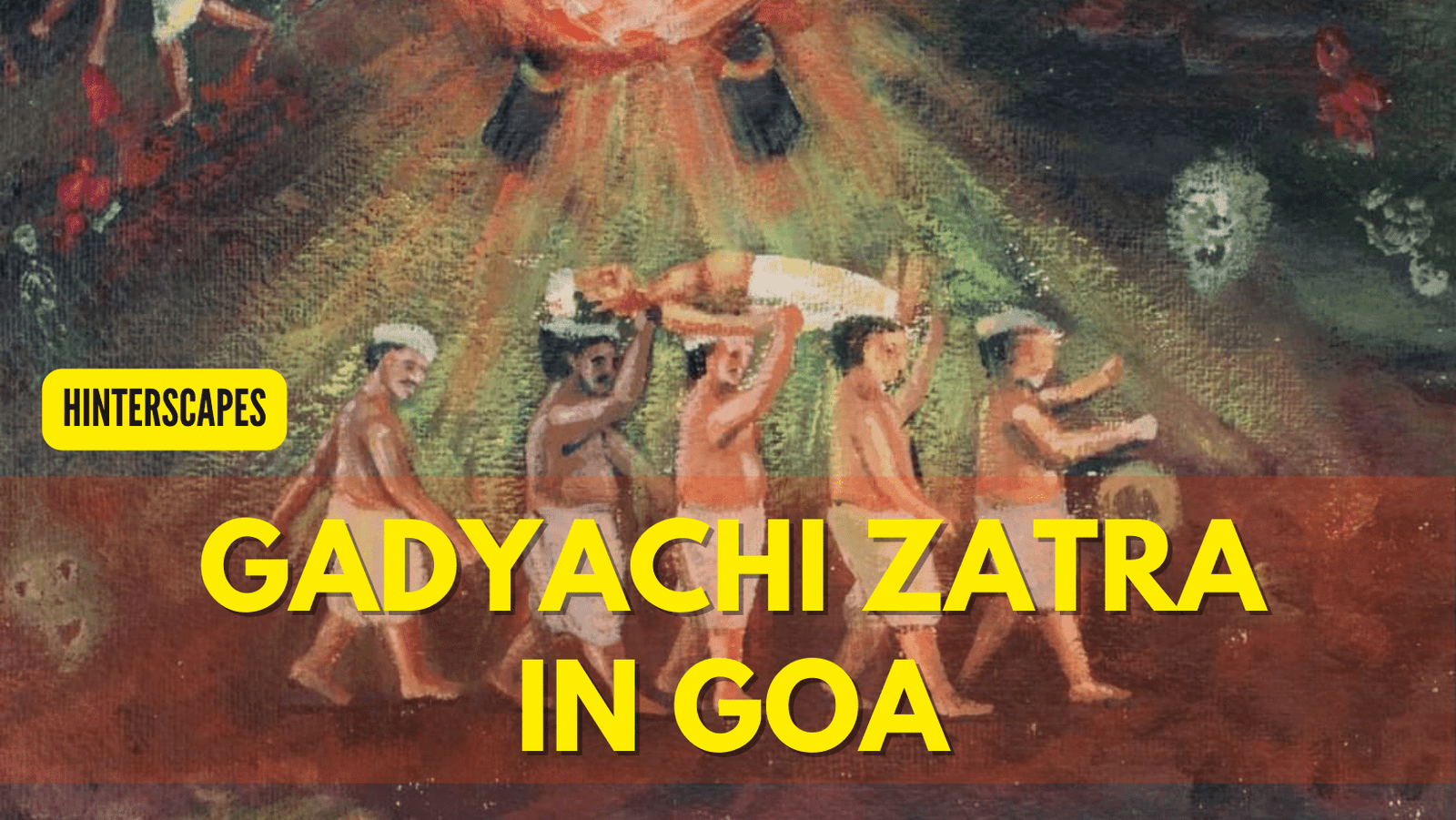Have you heard of worshiping a demon? Yes! You heard it right. This unique Goan festival is one of a kind in entire world. The Gadyachi Zatra is a unique celebration in Goa, where certain communities honor both God and demons. This type of zatra, which honors the denvchaar, is celebrated in several places in Goa, often in connection with the Shigmo festival. Sal, Borde-Bicholim, Pilgao, Kudne, and Savai-Verem are some of the places where Gadyachi Zatra is celebrated.
The festival is particularly dedicated to the denvchaar. Denvchaar is a demon-like entity that is not to be confused with evil spirits or the devil. In fact, the denvchaar is considered a protective force in the community and is also known as rakhno or protector. According to locals, the denvchaar is a supernatural entity that safeguards the village and its inhabitants. Mahadeshwar is responsible for overseeing all the Rakhandar in the village and is worshipped as the deity of the gade. Overall, the Gadyachi Zatra is a fascinating example of how certain communities in Goa embrace both the divine and the supernatural in their cultural practices.

The festival is known as Gadyachi Zatra because it involves the participation of gades, who are designated male devotees dressed in white dhotis, and are considered the main performers of the ritual. During the ceremony, these devotees attain the avatar of the god and play a significant role in the proceedings. While other devotees are also present, they are not allowed to participate directly in the zatra.
Unique Festival of Gadyachi Zatra or Gadeutsav at Sal, Bicholim, Goa
The most well-known celebration of Gadyachi Zatra takes place in Sal, Bicholim. This event is attended by large crowds from both Goa and neighboring areas of Maharashtra and Karnataka. The festival involves the selection of 52 individuals from communities such as Raut, Parab, Naik, Ghure, Mhale, and Mesta to become the revered Gade. During the ceremony, the Gade, dressed in dhotis, circle a pole that represents the Holi on the mand, while under a trance-like state. It is believed that the Gade are guided by the Devchaar spirit, who uses a mysterious torch to lead them into the forest towards a hill.
Suggested Read: Shigmotsav in Goa, Holi Celebration in Goa
Sal is home to two significant temples: Mahadev and Bhumika. According to Hindu tradition, Mahadev prefers to meditate in the crematorium and is revered as the god of both holy and evil ghosts and spirits. During the Holi Pournima festival, a wooden trunk of mango tree adorned with mango leaves is placed in the mand, a sacred location in front of the Mahadev temple.
What exactly happens at Gade utsav in Sal, Goa?
The evening after Holi Pournima, individuals dressed in white dhotis, with a kare/करे (small budkulo of clay) in hand and bare torsos, gather at the mand. A crowd (romat) arrives, dancing to the beats of dhol and tasho. The villagers then perform garanes, singing to all the deities of the village, to seek their blessings. This tradition begins before midnight and includes the recitation of garanes by a bhat. This bhat or Pandit is already present at the mand to fulfill any vows made by the devotees.
During this event the whole village is covered with darkness. Not even street lights or light emitting from mobile phones are allowed.
The gades, who are selected by the deity, enter into a trance, which indicates that they have been chosen. It could be a member or multiple members of a family who are selected. They circle around the holi and spot the uzvaddi (fire), made of palm leaves, which is shown by the devchaar. The gades then run towards the fire. Other devotees present at the temple stand at a distance and can also see the fire.
Hide and Seek with the Devchaar at Sal Gade, Bicholim, Goa
Meanwhile, the devchaar teases the gades by popping the fire at different places, including on top of trees, before leading them into the forest, where it is easier to hide and tease them. Locals attending the zatra for last several years, say that everyone present can see the fire. The devchaar takes two or more gades as prisoners and keeps them hidden. The remaining gades return to the mand and place the kare near the holi. The number of gades who have been taken as prisoners is indicated by the number of kares left behind.
The gades rush back to the mandd to search for their companions. The ones who are found are usually in a trance-like state and are carried back to the mandd by four gades. They are then taken around the holi and are revived. This same process is repeated for the next two days. The namans must be continuously sung without stopping, as any break might harm the gades. Similarly, the namans are not stopped until the devchaar leaves the gades. If a gade is not found by the last day, it is believed that they will not survive until the next year, when they will search for them again.
Removing the Evil-eye and Negativity at Sal Gade, Goa
A unique aspect of the Gadyachi Zatra is the belief that a jealous person’s curse can prevent a gade from getting into the trance state. If this happens, the gade is informed of the curse. So, both the person and the gade visit the Bhoomika temple to pray and remove the ill-feeling. This demonstrates the significance of collective faith and the belief in the power of prayer to overcome negativity.
On the third and final day, the gades, still in a trance, make their way to the crematorium to collect the remains of the dead bodies and unburnt logs. After performing some rituals and taking rounds of the holi, they return the remains to the cemetery. What is intriguing is that each gade knows what they brought back from the cemetery.
It is said that inside the cemetery, which is in darkness, the wailing of women and infants can be heard. Locals believe that this may be due to the gades using their waist strings to hit the souls. These souls may be of women who died during childbirth, known as the avgont. In Goan culture, there are superstitions surrounding the death of these women, especially if they were unable to deliver the child. It is considered a bad omen, as the woman died without fulfilling her duty of giving birth to a child. As a result, her spirit is believed to linger on earth and is often labeled as an evil spirit.
After completing the rituals, the gades return to their normal state and have no recollection of what occurred when they were possessed or in a trance state. This is all about this unique Goan festival which is one of a king in entire world.
Gade Utsav or Gadyachi Jatra at Kudane, Goa – A unique Goan festival
Interestingly, in the village of Kudne, the same jatra takes place for three days without illuminating any torches or lamps. Despite the absence of light, this mesmerizing festival remains a unique and captivating experience.
We at Hinterscapes take you to a Goa tour from a different angle. Goa is beyond beaches and night life. Visit our website and book your most affordable package which will give you a Goan feel of anything you do. Experience the real magic of Hinterland tourism in Goa.
Suggested Read: 14 Bizzare Festivals in Goa that will Leave You Thrilled
Don’t forget to follow us on Instagram to watch few amazing videos of unseen Goa. Stay tuned to our blog to read more of such interesting articles on unique Goan festival as well as other minute details about Goa. Please tell us in comments how you felt about this unique Goan festival.





